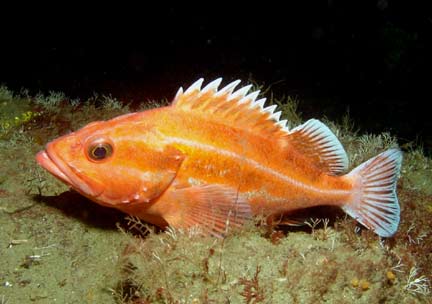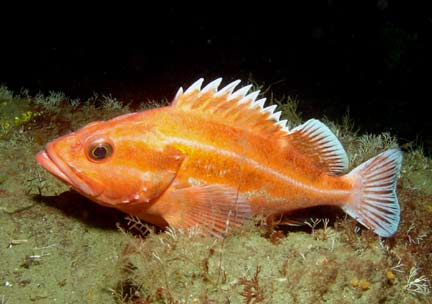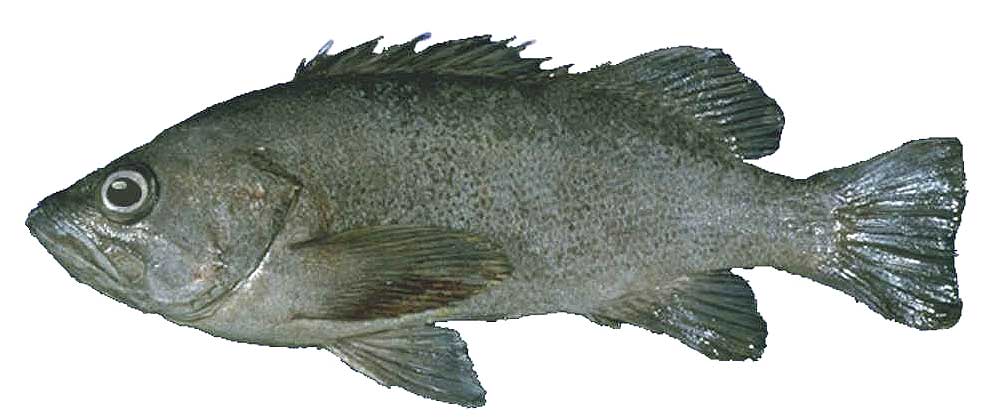Other: Other Related Research
Rockfish
By Jeffrey Jacobs (05/12/09 11:32:34)
Related animal: Rockfish
Rockfish
I first became interested in rockfish after our class visit to the UCSB REEF where about eight rockfish live together in a large circular tank. I was originally drawn to them after learning that even though they are kept within such close proximity to one another, they are incredibly territorial creatures and each occupy and respect the spaces dominated by the other rockfish in the tank. I saw this as an opportunity to do some sort of animal collaboration involving the mapping out of these overlapping tiny rockfish private properties that occur within the tank.
There are more than thirty species of rockfish that live in the Pacific coastal waters of North America, mostly living in the Gulf of Alaska. They can be as large as 41 inches long and as short as five inches, but most of them are between 20 and 24 inches. They are characterized by their bony spines on their heads and bodies. The spines are venomous, and although they are not toxic enough to be dangerous to humans, they can still cause pain and infection. Rockfish are somewhat bass like in shape and are sometimes referred to as sea bass. They are a common seafood and the most common species to be eaten are the yelloweye, quillback, copper, dusky and black. In the wild, rockfish are spilt u into three categories, shelf demersal, shelf pelagic and slope. Shelf demersal rockfish are those that live close to the shore, in shallow rocky waters. Shelf pelagic rockfish also live near shore, however they tend to spend most of their time occupying the water column up off the sea floor. Slope rockfish live in deeper waters, close to the continental shelf.
Rockfish are ovoviviparous, which means that they give birth to live young after they are fertilized internally. Rock fish grow very slowly and live long lives. Black rockfish do not become sexually mature until they are around ten years old and can live up to forty years. Other species such as the yelloweye do not become sexually mature until they are 15 years old and can live more than 100 years. The oldest rockfish to be found in the wild to date was confirmed to be 114 years old. Most species live their entire lives at a specific site and if they are captured and relocated they are known to swim back to their original site.
Young rockfish mostly eat plankton as well as small crustaceans and fish eggs. Adult rockfish eat fish such as sand lance, herring, and small rockfish, as well as crustaceans. Rockfish have a type of swim bladder that uses a special gas-producing and absorbing gland to change the volume of gas in the swim bladder, which is used to maintain buoyancy at different depths in the water. These swim bladders are damaged when fishermen reel rockfish to the surface too quickly for the gland to adjust properly. They often expand so quickly that they explode out the fish’s mouth, and tragically countless rockfish are killed this way every year by fishermen who throw them back while trying to catch halibut and salmon.
[Write Comment]
By Jeffrey Jacobs (05/12/09 11:32:34)
Related animal: Rockfish
Rockfish
I first became interested in rockfish after our class visit to the UCSB REEF where about eight rockfish live together in a large circular tank. I was originally drawn to them after learning that even though they are kept within such close proximity to one another, they are incredibly territorial creatures and each occupy and respect the spaces dominated by the other rockfish in the tank. I saw this as an opportunity to do some sort of animal collaboration involving the mapping out of these overlapping tiny rockfish private properties that occur within the tank.
There are more than thirty species of rockfish that live in the Pacific coastal waters of North America, mostly living in the Gulf of Alaska. They can be as large as 41 inches long and as short as five inches, but most of them are between 20 and 24 inches. They are characterized by their bony spines on their heads and bodies. The spines are venomous, and although they are not toxic enough to be dangerous to humans, they can still cause pain and infection. Rockfish are somewhat bass like in shape and are sometimes referred to as sea bass. They are a common seafood and the most common species to be eaten are the yelloweye, quillback, copper, dusky and black. In the wild, rockfish are spilt u into three categories, shelf demersal, shelf pelagic and slope. Shelf demersal rockfish are those that live close to the shore, in shallow rocky waters. Shelf pelagic rockfish also live near shore, however they tend to spend most of their time occupying the water column up off the sea floor. Slope rockfish live in deeper waters, close to the continental shelf.
Rockfish are ovoviviparous, which means that they give birth to live young after they are fertilized internally. Rock fish grow very slowly and live long lives. Black rockfish do not become sexually mature until they are around ten years old and can live up to forty years. Other species such as the yelloweye do not become sexually mature until they are 15 years old and can live more than 100 years. The oldest rockfish to be found in the wild to date was confirmed to be 114 years old. Most species live their entire lives at a specific site and if they are captured and relocated they are known to swim back to their original site.
Young rockfish mostly eat plankton as well as small crustaceans and fish eggs. Adult rockfish eat fish such as sand lance, herring, and small rockfish, as well as crustaceans. Rockfish have a type of swim bladder that uses a special gas-producing and absorbing gland to change the volume of gas in the swim bladder, which is used to maintain buoyancy at different depths in the water. These swim bladders are damaged when fishermen reel rockfish to the surface too quickly for the gland to adjust properly. They often expand so quickly that they explode out the fish’s mouth, and tragically countless rockfish are killed this way every year by fishermen who throw them back while trying to catch halibut and salmon.

Yelloweye Rockfish | 
Yelloweye Rockfish |

Black Rockfish |